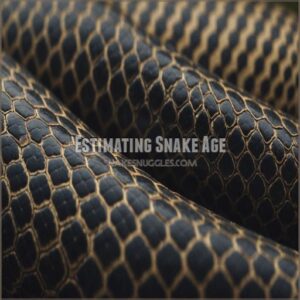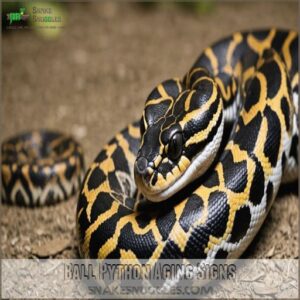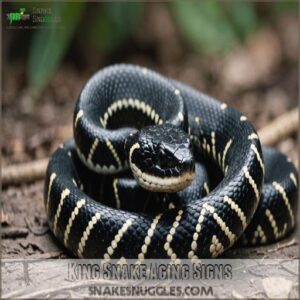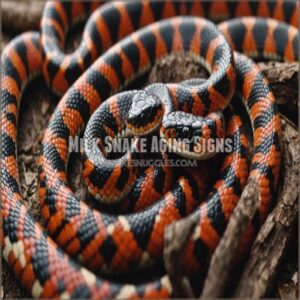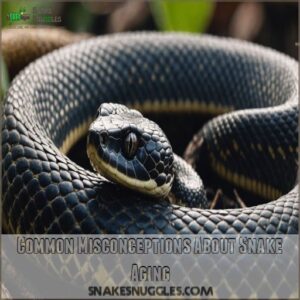This site is supported by our readers. We may earn a commission, at no cost to you, if you purchase through links.
 Want to know how to tell a snake’s age?
Want to know how to tell a snake’s age?
Start by checking its length and weight, but remember, these can vary by species.
A snake’s pattern change over time, like a chameleon with a fashion sense, hints at aging.
Look at the head size too; a bigger noggin suggests maturity.
Some snakes could even change color subtly as they age.
Injuries or old scars might also tell tales of its past adventures.
But just like humans, every snake’s unique.
Stay tuned, because next, you’ll learn about species-specific tips that could make you the snake-age guru of your neighborhood!
Table Of Contents
- Key Takeaways
- Physical Changes in Snakes
- Behavioral Changes in Snakes
- Estimating Snake Age
- Species-Specific Aging Characteristics
- Factors Influencing Snake Aging
- Expert Guidance and Emerging Technologies
- Reproductive Maturity and Aging
- Aging Signs in Specific Snake Species
- Caring for Older Snakes
- Common Misconceptions About Snake Aging
- Frequently Asked Questions (FAQs)
- How can you tell if a snake is old?
- How old do Snakes get?
- How do you know if a rattlesnake is old?
- How can you accurately age a snake?
- How can you tell a snake’s age?
- Can you tell the age of a snake by its rattles?
- Do snakes show signs of age?
- What age is an adult snake?
- Can I use shed skin to estimate age?
- Do albino snakes age differently?
- How does diet affect snake aging?
- What about snakes with genetic mutations?
- Does habitat impact lifespan?
- Conclusion
Key Takeaways
- You’ll find that observing physical changes like length, weight, and a snake’s head size can give clues about its age, but remember, these vary widely by species.
- Shedding frequency decreases and coloration changes over time, with younger snakes shedding often and older ones showing duller or darker patterns.
- Behavior is a significant indicator; older snakes may be less active, eat less frequently, and show reduced interest in exploring new environments.
- Consulting experts or using emerging technologies like DNA analysis can provide more accurate insights into your snake’s age, considering species-specific characteristics.
Physical Changes in Snakes
You’ll find that a snake’s age isn’t written on its scales, but you can learn to read the clues!
Changes in growth rate, shedding patterns, coloration, and even body shape all provide hints about how old your slithery friend might be.
Growth Patterns and Size
Ever wondered how you can tell a snake’s age?
It all boils down to growth patterns and size.
King snakes can gain about 2 inches monthly, according to King Snake Growth Rates. Young snakes grow fast—think doubling their length in the first year!
Growth rate variations hint at age-related growth, while size comparisons, length to weight ratio, and body proportions reveal snake size and growth.
Each species-specific aging sign offers important clues.
Shedding Frequency and Skin Condition
As your snake grows, you’ll see shedding frequency tell a story about its age.
Young snakes, busy sprouting up, shed plenty.
Adults slow it down a bit.
A closer look at skin condition can reveal health clues.
Think sunscreen for scales!
- Young snakes shed more frequently.
- Check shed skin for growth history.
- Skin condition reflects health status.
Color Changes and Patterns
After shedding, you’ll notice how a snake’s color might fade or darken over time.
This change often signals aging.
Albino snakes and other varieties are influenced by genetic factors and environment, such as their natural aging process, much like how you tan in the sun.
Breeding practices impact these shifts too, giving insight into snake behavior changes and reproductive maturity.
It’s nature’s palette at work!
Body Shape and Proportions
Spotting snake aging signs involves checking body shape and proportions.
A young snake has a narrower head, while older ones show a noticeable head width increase.
Body girth expands with age, creating fatty deposits near the vent area.
Keep an eye on spine visibility—an indicator of aging and muscle loss.
These signs help unravel your snake’s secret lifespan story.
Behavioral Changes in Snakes
As snakes age, you might notice your slithery friend moving less, like a teenager on a lazy Sunday, and preferring smaller, more manageable meals.
They may also lose interest in exploring new territories and become either more tolerant or crankier about being handled, much like a grumpy grandparent.
Activity Levels and Energy
The ebb and flow of energy in snakes offer clues to their age.
Older snakes often enter an age-related slowdown, moving less to conserve energy.
You might see a winter lethargy set in as they prefer sunbathing over exploration.
This mellowing shift in activity levels is part of their natural wear and tear, signaling their advanced life stages.
Feeding Habits and Prey
Someone once said, "You are what you eat," and that’s true for snakes too.
As your snake ages, you might notice dietary changes.
To better understand these changes and estimate your snake’s age, you can use tools like a snake age calculator.
Older snakes often eat less frequently, and sometimes struggle with larger prey.
Understanding your snake’s prey size and food preference is key to proper snake care, especially during snake breeding.
Keep an eye on feeding frequency; it’s a useful clue in snake age estimation, along with other behavioral shifts.
Remember, proper snake identification helps you understand species-specific dietary needs and lifespan.
Exploration and Environmental Interaction
Curiosity piques when you explore your snake’s behavior.
Their environmental interaction can reveal their age as older snakes tend to be less adventurous.
Here’s what to watch for:
- Changes in habitat preference
- Signs of territory marking
- Traits of shelter seeking
- Patterns in prey tracking
- Reactions to environmental cues
These details guide your understanding of snake aging.
Handling and Socialization
Handling a snake requires finesse, like taming a misunderstood friend.
Younger, more curious snakes enjoy exploration, while older ones may grow less tolerant.
Socialization benefits both, fostering snake memory and even facial recognition.
Watch for temperament changes or stress indicators; they reveal age-related behavior shifts.
Mastering this art enhances snake care and management by providing insights into specific species needs, such as the fact that corn snakes can live up to 20 years in captivity, requiring long-term commitment learning about corn snake care, ensuring harmony between humans and their slithering companions.
Estimating Snake Age
Estimating a snake’s age is a bit like piecing together a scaly puzzle—you’ll need to factor in their size, shedding patterns, coloration changes, and behavior.
While it’s not as simple as counting scales, these clues can give you a pretty good idea of how old your slithering friend might be.
Size and Growth Rate Considerations
Noticing your snake slowing down lately?
While behavior hints at age, size and growth rate paint a fuller picture.
Growth rate variability is key; snakes mature differently across species.
Compare captive and wild snakes, as diet and environment also play roles.
A ball python’s average lifespan, which can range from 20-30 years according to the lifespan of pet snakes, ages uniquely compared to a corn snake, influenced by breeding history and hormonal changes.
Shedding Patterns and Skin Analysis
You’ve checked the size, now think about shedding.
Young snakes shed their skin more frequently—it’s like them getting new clothes.
As explained in the snake skin shedding process, they typically shed 2-4 times per year, with younger snakes shedding more frequently.
Analyze the shed skin, as the frequency of shedding changes with age.
Older snakes shed less and may have rougher skin, signaling reptile aging.
This pattern helps gauge age while also offering clues about snake health risks and care needs.
Coloration and Pattern Changes
After examining shedding patterns, take a closer look at your snake’s scales. You’ll notice:
- Color fading: Snakes like albinos might lighten over time.
- Pattern variation: Each snake ages uniquely, showing individual differences.
- Environmental impact: Sunlight can alter colors, affecting corn and king snake appearance.
- Species-specific changes: Adult milk snakes’ hues may dull, unlike younger, vibrant garter snakes.
Behavioral Observations
Beyond color, watch your snake’s behavior.
Older snakes often slow down; their activity levels decrease.
Feeding patterns change, with less frequent meals.
Exploration wanes; they’re less interested in new things.
Their response to stimuli might also alter.
While there’s no magic number for snake death age, these shifts can offer clues, even if they aren’t foolproof.
Remember, every snake’s a unique character!
Species-Specific Aging Characteristics
Different snake species have unique aging characteristics that can help you gauge their age like a pro.
From the ever-growing ball python to the corn snake that seems to stretch endlessly, learning these species-specific traits can make you the snake age whisperer you never knew you wanted to be.
Ball Python Age and Size
Imagine this: your ball python, a scaly Houdini, grows inch by inch.
Hatchlings start around 10 inches and may tip 100 grams.
By one year, they stretch to 32 inches and bulk up to 800 grams.
As they mature, you’ll marvel at 40-inch adults.
Monitor ball python growth charts for trends and size variations, ensuring health throughout their impressive lifespan.
Corn Snake Age and Size
Ever wondered how to gauge your corn snake’s age?
Corn snakes start as hatchlings around 10-15 inches, weighing just 6-8 grams.
At one year, they reach 24-40 inches and weigh 35-100 grams, with females usually heavier.
In captivity, their lifespan can surprise you, often exceeding wild counterparts.
Check growth charts to track size and make sure you provide the best care.
King Snake Age and Size
King snakes, often charming reptile companions, vary in size as they age.
Hatchlings start at 8-11 inches, while adults reach 35-41 inches.
Females tend to edge out males in length, with maturity impacting their weight too.
As you observe these variations, remember growth rates differ, hinting at King snake aging signs and unique size quirks that make each snake special.
Milk Snake Age and Size
Celebrate the charm of milk snakes with their mesmerizing patterns!
To decipher a milk snake’s age, observe its growth, which begins with hatchlings at just 5-10 inches.
As they mature, expect lengths of 20-60 inches, influenced by genetics and habitat.
Don’t be surprised when milk snake care involves checking size as these factors impact lifespan and aging gracefully.
Rat Snake Age and Size
As milk snakes boast vibrant patterns, rat snakes impress with their unique growth.
Understanding rat snake age means knowing their impressive size variations.
Hatchlings start tiny at 13 inches but can reach hefty lengths of 10 feet.
Keep an eye on their weight and shedding frequency for clues to their age.
- Tiny hatchlings
- Lengthy adults
- Weight changes
- Shedding clues
- Hefty sizes
Factors Influencing Snake Aging
You’ll find that a snake’s lifespan isn’t just about time; it’s a complex mix of what they eat, where they live, their genes, and their overall health.
Think of it like this: even identical twins can age differently, and the same holds true for snakes!
Diet and Nutrition
Spotting snake age often starts with species traits, but don’t overlook diet and nutrition.
Meeting nutritional needs can slow aging, while improper diets might speed it up.
Offering a balanced prey variety helps proper growth.
Watch for digestion issues—feeding frequency and dietary supplements help you strike a balance.
It’s comparable to humans picking the right salad mix!
Environmental Conditions
Think of a snake’s home as a tiny climate experiment.
You’ll need to juggle these environmental factors:
- Temperature: Snakes are cold-blooded, so balance is essential.
- Humidity: Keeps their skin healthy.
- Substrate: This is their bedding, affecting warmth and moisture.
- Lighting: Mimics natural cycles to regulate activity.
These elements shape their growth and aging.
Genetics and Breeding
Genetic diversity spices up the aging game in snakes.
Through breeding programs and captive breeding, you might witness fascinating color mutations and quirky inheritance patterns.
Imagine a snake’s colors changing like a magical chameleon!
These variations aren’t just cool— they offer clues about age and adaptation.
Understanding these genetic traits helps you better care for your scaly friend.
Health and Disease
As you consider genetics and breeding, remember that a snake’s health plays a key role in its aging process.
Regular vet visits help prevent disease and help control common ailments like parasites.
Keep an eye on your snake’s health; it’s like having a robust immune system, which isn’t just good—it’s age-defying!
Prioritize snake health for longevity and quality of life.
Expert Guidance and Emerging Technologies
Turning to experts like herpetologists and breeders can help you uncover the age mysteries of your scaly friend with ease.
Emerging technologies like DNA and scale analysis are providing exciting new paths, proving snake-aging isn’t just for Indiana Jones wannabes anymore.
Consulting Herpetologists and Breeders
You’ve got questions about your snake’s age, and consulting herpetologists and breeders might just crack the case.
These experts offer a unique peek into growth patterns, genetics, and breeding ethics.
Consider reaching out to reputable snake breeders who’ve extensive knowledge of lineage, genetic diversity, and health records.
Make sure ethical sourcing to prevent over-exploitation.
Discuss captive breeding impacts on snake care. Proper breeding preparation and post-egg care are crucial to avoid stress in responsible snake breeding, as breeding schedules can impact longevity.
Explore genetic testing options to refine age estimation.
Think of them as your snake’s personal detectives!
DNA Analysis and Scale Analysis
Figuring out a snake’s age is getting easier!
DNA analysis offers a promising path to accuracy.
While cost can be a factor, this method holds immense potential.
Imagine pinpointing a snake’s age with precision!
Future applications are exciting, but ethical concerns surrounding sample collection must be addressed.
Scale analysis, another emerging tool, provides complementary data, creating a more complete picture.
Limitations of Age Estimation Methods
While DNA and scale analysis promise accuracy, using a snake age chart can help give additional context but the picture isn’t perfect.
You’re often left juggling species variation and individual differences, like a chef with too many ingredients.
Environmental impacts stir the mix, and data scarcity often leaves you in the dark.
These accuracy limitations show why expert advice remains essential.
Think of it as a trusty flashlight in a dimly lit room.
Reproductive Maturity and Aging
When figuring out a snake’s age, you’ll find that reproductive maturity is a major clue, much like puberty for teenagers.
By examining their reproductive organs, you can estimate age since snakes, much like humans, mature at different times depending on the species.
Species-Specific Reproductive Ages
After considering expert guidance, you might wonder when snakes reach reproductive maturity.
Here’s where species differences show up.
Ball pythons typically mature around 3 to 5 years, while corn snakes might be ready at just 18 months.
Breeding practices often hinge on understanding these ages, affecting snake lifespan and age-related health.
It’s fascinating how nature sets its own timetable!
Examining Reproductive Organs
Spotting a snake’s age might lead you to examine reproductive organs.
Think of it as a detective toolkit, revealing secrets on their reproductive maturity.
Here’s what to keep in mind:
- Sex determination helps with age clues.
- Check for signs of the breeding season.
- Assess organ health for aging indicators.
- Don’t forget ethical considerations when examining.
Each insight brings you closer to the mystery-solving moment.
Impact of Reproductive Maturity on Aging
When snakes reach reproductive maturity, you might notice lifespan changes in your slithery pet.
Breeding impact is fascinating; it shifts aging signs and maturity indicators.
It’s like a reptile rite of passage!
Check out this quick guide:
| Aspect | Impact |
|---|---|
| Growth Rate | Slows |
| Shedding Frequency | Decreases |
| Activity Levels | Decline |
| Color Intensity | Reduces |
| Metabolic Rate | Decreases |
Aging Signs in Specific Snake Species
Now that you’ve learned about general snake aging, ball pythons, for instance, can grow up to average adult ball python size, let’s explore how specific species show their age, from the subtle shifts in a corn snake’s pattern to the more dramatic changes in a ball python’s size.
Understanding these species-specific clues will help you better estimate your scaly friend’s age, maybe even guessing closer than you think!
Ball Python Aging Signs
As ball pythons age, their telltale signs become your best clues.
Watch for changes in ball python growth, like slower growth rates and reduced shedding frequency.
Color changes, often a subtle darkening, can hint at maturity.
Look at their head shape—it becomes broader with age.
And don’t forget to notice body fat; it increases over time, especially in captivity.
Corn Snake Aging Signs
From spotting fades in ball pythons, now let’s explore corn snake aging.
Corn snakes show age through growth, shedding less frequently as they mature.
Their vibrant color transforms, offering hints about their timeline.
Observing corn snake behavior like reduced activity can signal aging, while lifespan variations influence the extent of these changes.
Keep an eye on these clues!
King Snake Aging Signs
Spotting a king snake’s age isn’t rocket science, but it’s a bit like piecing a puzzle together.
Notice any color changes or shedding patterns.
If its head size seems bigger compared to a younger snake, it’s likely older.
Behavior changes can also give clues; older snakes mellow out, while breeding impacts might alter their overall demeanor.
Milk Snake Aging Signs
Their lifespan in captivity can reach 22 years with proper care, including a balanced diet, healthy enclosure, and stress reduction, as discussed in the Milk Snakes Care Guide. Peering into milk snake aging reveals fascinating details. You’ll notice changes in milk snake color variation, as they lose that vibrant sheen with age.
Their lifespan influences shedding patterns; older snakes shed less often.
A quick milk snake size comparison helps, too. Young snakes, like many species, grow rapidly, often doubling their hatchling length in the first year, according to snake growth patterns.
- Color dulling over time
- Reduced shedding frequency
- Slower growth with maturity
Rat Snake Aging Signs
Aging rat snakes? It’s like watching your favorite shoes—comfortable, but faded. Rat snake color changes, with hues darkening over the years, shedding patterns adjusting as they mature. Look out for head size shifts and behavior changes.
Compared to milk snakes, rat snakes can reach a 10-foot lifespan milestone.
| Sign | Observation |
|---|---|
| Color Changes | Darkening hues |
| Shedding Patterns | Less frequent over time |
| Head Size | Broadens with age |
| Behavior Changes | Less active, more laid-back |
| Lifespan Possibility | Can reach up to 10 feet long |
Caring for Older Snakes
As your snake ages, it might need a little extra TLC to stay in tip-top shape, just like a fine wine demands the perfect cellar.
You’ll want to keep an eye on its diet and environment while scheduling regular vet check-ups to guarantee a happy, healthy senior slitherer.
Dietary Changes and Nutrition
Knowing your snake’s age helps you tailor its care.
As they get older, their appetites often change.
You might find your senior snake needs smaller, more frequent meals.
Think of it as their version of a senior citizen’s discount!
Maintain a balanced diet, possibly adding supplements to support their health in captivity.
Regular vet checkups are key, especially as their bodies age.
Remember, a healthy diet is a happy snake!
Environmental Adjustments
For older snakes, creating the perfect environment is as important as finding the right spot on the couch.
Adjust your enclosure by maintaining a stable temperature and ideal humidity—like fine wine, they age better in the right conditions.
As snakes age, environmental factors like diet and habitat influence their growth patterns more than time, so be mindful of these elements when understanding snake growth patterns.
Choose the right substrate to cushion those mature scales, and make sure the lighting mimics their natural habitat.
Health Monitoring and Veterinary Care
When your snake starts showing its age, keep them slithery and spry with regular check-ups. Here’s how:
- Preventive care: Schedule veterinary visits to catch any common ailments early.
- Parasite control: Stay ahead of pesky parasites that can sap energy.
- Proper handling: Gently handling your snake helps maintain trust and spot any health changes.
Common Misconceptions About Snake Aging
You might think counting a snake’s rattles or checking its size is a foolproof way to gauge its age, but these myths don’t hold up under scrutiny.
Understanding the truth means looking past these clichés and appreciating the unique growth journey each snake goes on.
Understanding Individual Variations
A snake’s age isn’t easy-peasy to judge just by looking.
Individual variations, like genetics and environment**, make every snake unique.
Research shows that factors like diet, genetics, temperature, and habitat influence snake aging, with well-fed snakes living longer.
Interested in their quirky personalities?
| Factor | Influence |
|---|---|
| Health | Impacts energy |
| Diet | Affects growth |
| Environment | Shapes colors |
Even in the wild, their age can be as slippery as their skin.
Importance of Accurate Age Estimation
Imagine you’re trying to pinpoint your snake’s age—it’s not just about curiosity.
It’s about ensuring proper Health, Breeding, and Captive care.
Accurate age estimation helps you provide the right diet and habitat and is essential for Conservation and Research efforts.
Misinformed guesses can lead to health issues or mismatched care, like fitting a size-nine foot into a size-six shoe!
Frequently Asked Questions (FAQs)
How can you tell if a snake is old?
Spotting an "experienced" snake involves noticing faded or darkened colors, less frequent shedding, and a wider head compared to the body.
Older snakes might act more reserved, eat less, and occasionally showcase prominent spines due to muscle loss.
How old do Snakes get?
Snakes can live surprisingly long lives.
Many species, like ball pythons, can reach 20-30 years in captivity.
Some tortoises and box turtles might envy them!
Yet, wild snakes often face shorter lifespans due to predators and environment.
How do you know if a rattlesnake is old?
You can spot an older rattlesnake by its faded patterns, worn rattles, and reduced activity.
Its skin might be rougher, and its spine could appear more prominent due to muscle loss.
Aging gracefully, just like us!
How can you accurately age a snake?
Estimating a snake’s age involves examining its size, shedding patterns, and coloration.
Younger snakes grow quickly and shed often, while older ones slow down.
For accuracy, consult a herpetologist or compare with known-age snakes.
How can you tell a snake’s age?
Figuring out a snake’s age involves checking size, shedding patterns, and behavior.
Younger snakes shed more and act lively.
Observe color changes; older snakes tend to fade.
Accurate records or consulting experts can also help.
Can you tell the age of a snake by its rattles?
Counting rattles isn’t always a foolproof way to age a rattlesnake.
Each shed adds a segment, but segments can break off.
While fun to count, remember it’s not a perfect age indicator, much like guessing birthdays!
Do snakes show signs of age?
Yes, snakes definitely show their age!
You’ll see changes in their shedding, color, and activity levels.
Their size and even their behavior can give you clues.
It’s like reading a reptile’s life story!
What age is an adult snake?
Snakes can become adults at about 2 to 5 years, depending on the species.
For example, ball pythons and corn snakes typically reach adulthood around 3 to 4 years.
It’s like hitting snake puberty, scales and all!
Can I use shed skin to estimate age?
You can estimate a snake’s age using its shed skin, but it’s more art than science.
Younger snakes shed more frequently, so track the shedding to glimpse their growth rate and possible age range.
Do albino snakes age differently?
Albino snakes don’t age differently, but they show unique changes, like altered pigmentation, as they grow older.
You might notice some color variation and texture changes, like rougher skin, making them a bit more unique.
How does diet affect snake aging?
The diet of a snake greatly influences its growth and aging process.
Providing a balanced diet promotes good health, whereas a poor diet may cause stunted growth and accelerated aging.
Think of it like fueling a high-performance engine.
What about snakes with genetic mutations?
Picture a snake with kaleidoscope colors.
Genetic mutations can cause unique pigmentation, size, or scale changes.
Just like people, each mutated snake’s appearance is one-of-a-kind.
These quirks can be fascinating but tricky for age guessing.
Does habitat impact lifespan?
Habitat plays a huge role in a snake’s lifespan.
Snakes in stable, resource-rich environments often live longer.
Stressors like predators or scarce food can cut lives short.
So, be the snake’s interior decorator for a longer life!
Conclusion
So, you’ve learned a bunch about how to tell a snake’s age, right?
Remember, accurately determining a snake’s age isn’t always easy; it’s more of an educated guess than an exact science.
Factors like diet and environment play a big role.
While size and shedding patterns offer clues, species-specific knowledge is key.
Comparing your snake to established growth charts for its species will help you narrow down its age.
Keep learning, keep observing, and you’ll become a pro at figuring out how to tell a snake’s age!



